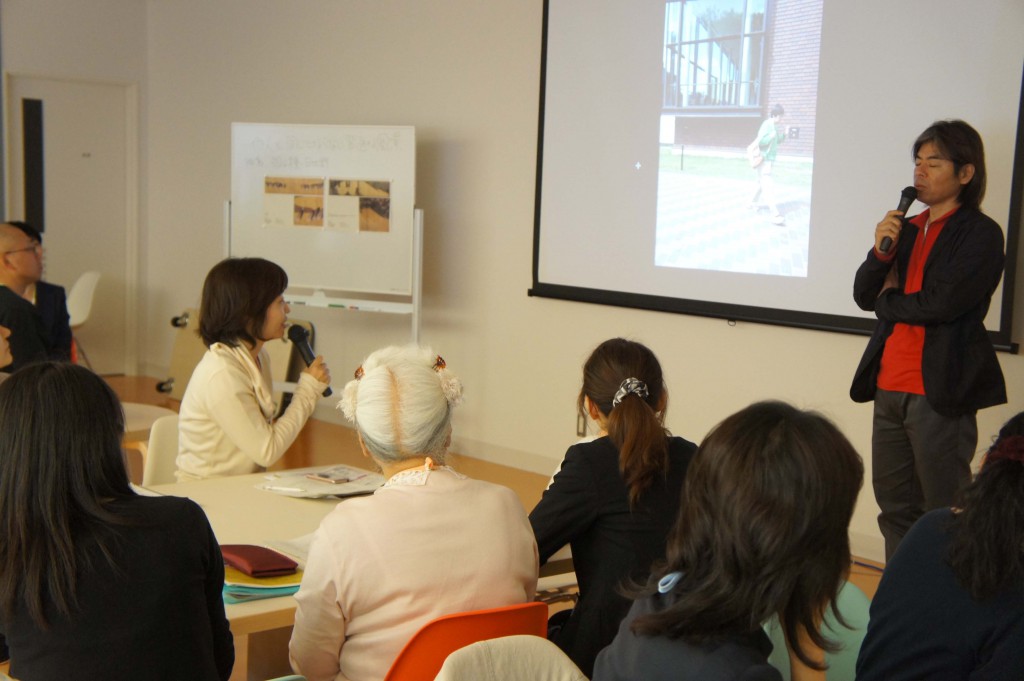
2012.05.19
Between the Foundation Courses held every other weekend (Friday, Saturday, and Sunday), there is a seminar day (called “TOBI Lab”) to create gently stimulating activities. The TOBI Lab offered on Saturday, May 19th was a meeting to consider the “Tsuzuri Project” with curator Ms. Sawako Inaniwa as a leader. This is a project featuring high-definition copies of 2 pairs of 6 panel byōbu (Japanese folding screens) that are scheduled to be donated by Canon.
2012.05.19
隔週で行われている基礎講座の間の週の金土日は、ゆるやかに刺激的な活動をつくるための研究会の日(通称とびラボ)です。5月19日(土)に行われたとびラボは学芸員の稲庭彩和子さんを中心に「綴プロジェクト」について考える会でした。「綴プロジェクト」とは、キヤノンから寄贈頂くことを予定している高精細複製品の6曲1双の屏風2双を使ったプロジェクトです。<「桜図屏風:さくらずびょうぶ」(伝俵屋宗達筆)、「群鶴図屏風:ぐんかくずびょうぶ」(尾形光琳筆)の高精細複製品>複製品といってもキヤノンの技術をつくした一品で、金箔は本物、貴重な資料です。「綴プロジェクト」では、この屏風を使ってどんなことができるか、現在とびラー候補生ともども考えを巡らせています。本物と違って、ガラスケースにいれて鑑賞する必要はなく、弱視の方により近距離で鑑賞頂くこともできます。また、展示室ではなく、例えばロウソクの明かりで屏風をみるなど、日常の生活空間の中で屏風の存在を感じる試みも可能です。「綴プロジェクト」面白くなりそうです。(伊藤)
2012.05.12
基礎講座もついに3回目。午前中の講師は学芸員の佐々木秀彦さん。「都美はコレクションではなく、コネクションで勝負する」「欧米の美術館を手本にするだけでは通用しない、日本なりの美術館の在り方を考えなければならない」など、都美の学芸員の視点ならではの、熱く、率直なお話を伺うことができました。
レクチャーの後は、美術館のバックヤードツアー。ちょうど公募展の搬入が行われており、普段は見る事の出来ない舞台裏を見学させて頂きました。
午後は日比野克彦さんによる「アートプロジェクトの記録・調査・アーカイブ」と題した講座が行われました。前半は日比野さんが現在取り組まれている「種は船」プロジェクトに関連して行われるアーカイブプロジェクト「船は種」を題材に、アートプロジェクトを記録する上で、埋没しがちな参加者個々人の体験や記憶を浮かび上がらせることの重要性についてお話頂きました。
撮影を終了した後は再度アートスタディルームに戻り、日比野さんのファシリテートのもと、とびラー候補生が各自撮影した写真から想起される言葉を紡ぎだして行きました。写真は自身の体験や記憶に向き合うきっかけであり、なおかつ自分以外の人と体験や記憶を共有する入り口にもなりました。プロジェクトを進める上では、全体の足並みをそろえて歩むことが大事です。しかし、共通の体験をしたとしても、感じ方や考え方などその受け止め方は、人それぞれ。そのそれぞれ違った多様な受け止め方を声にして、価値あるものとするからこそ、プロジェクトにさらなる広がりが生まれるのだと感じました。(伊藤)
2012.05.12
We’ve finally reached the 3rd Foundation Course. Our morning instructor was the curator, Hidehiko Sasaki. We were able to hear the passionate and frank comments from the perspective of a TOBI curator such as, “TOBI is based not on collections, but connections” and “Just using Western art museums as an example does not apply. We have to think of the best way for Japanese art museums.”
After the lecture, we toured the “back yard” of the Museum. There was an exhibition just being delivered, so we got a behind the scenes tour that you don’t normally get to see.
In the afternoon, there was a course by Katsuhiko Hibino titled “Recording, Inspecting and Archiving of Art Projects.” Using the archive project “Ships are Seeds” related to the “Seeds are Ships” project that he is presently undertaking, in the first half Hibino-san discussed the importance of, after recording the art project, highlighting such things as the experiences and memories which emerge from each individual participant that tend to be buried.

In the second half, based on the lecture, there was a workshop to experience ways to draw out personal experiences and memories and such. The themes from Hibino-san were “while looking at the regular background, we all see things differently.” After taking pictures with a portable camera, through dialogue with others we went about putting into words things like the experiences and memories evoked by one of the pictures. We then promptly went out and began taking pictures around the Museum.

After taking the pictures, we returned to the art study room once again. With Hibino-san facilitating, the TOBIRA candidates spun out words evoked by each of their pictures. Pictures are chances for us to face such issues as our own experiences and memories, and also became an entry way for us to share these things with others. With the Project progressing, it is important for everyone to move forward together. However, even with a common experience, how one feels, thinks and receives it is different for each individual. I felt that giving a voice to these different ways of receiving the experience will make it valuable and further broaden the project. (Itō)